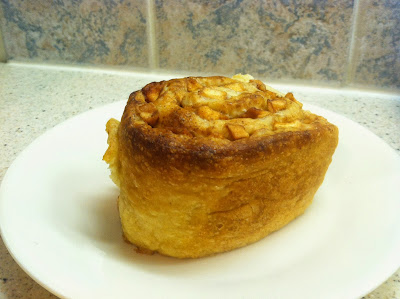They're easy to make and can even be put together the night before, so you don't have to wake up at the crack of dawn to have delicious rolls ready for breakfast. Another great thing about these rolls is that all you need to do is swap out the butter for coconut oil and they will be vegan. Go ahead and make these for your next holiday (or post-holiday) brunch, and enjoy. Merry Christmas and Happy Holidays to all!
Dough adapted from these rolls on My New Roots
Ingredients
For Dough:
2 cups flour (whole wheat pastry flour or all-purpose)
1 Tbsp instant yeast
2 Tbsp coconut sugar
1 tsp sea salt
3/4 cup unsweetened applesauce
3 Tbsp butter or coconut oil
For Filling:
2 medium tart apples, peeled and finely diced (I used Arkansas Black)
1 scant Tbsp ground cinnamon
1/8 tsp nutmeg
2 Tbsp orange blossom honey, plus additional for glaze
1/2 cup chopped pecans (optional)
Directions
1. In a medium mixing bowl, whisk together dry ingredients for dough.
2. In a small saucepan, heat together butter/coconut oil and applesauce just until fat is melted (if it's too hot, it will kill the yeast!).
3. Stir the wet mixture into the dry ingredients until a sticky dough is formed. Turn out into a floured surface and knead until dough is elastic and just slightly sticky. NOTE: for me, the dough wasn't coming together in the bowl, so I turned it out and mixed it together on the counter. It came together well, and I even kneaded more flour into it.
4. Lightly coat a large bowl with oil. Place dough in the bowl and turn over once. Cover bowl and allow to rest in a warm place until doubled in bulk, 1-2 hours.
5. Meanwhile for filling, toss together diced apples, cinnamon, nutmeg, and honey. Set aside.
6. Turn dough out onto a floured surface. Roll out into a 6x18" rectangle. Spread filling evenly over top, then sprinkle with chopped pecans if desired. Make a tight roll, starting on the short end. Slice into seven rolls, then place rolls in a greased round 8" or 9" pan. Cover and let rest until risen, about 1 hour. NOTE: once you've put together the rolls, you can cover them in plastic and refrigerate overnight. Take them out in the morning and let them warm and rise in a warm place - such as in front of the wood burning stove at your parents' house!
7. Once risen, bake rolls in a preheated 325 degree F oven for 25-30 minutes, or until golden. Serve warm. If desired, drizzle some warm honey over rolls before serving (they're delicious with or without).
Makes 7 rolls





